“Nine Lives – Twenty Images” – Dr. Julie Butler and The 145th Street Animal Hospital
Introduction: Many years ago when I was starting out on my photographic journey, I went to an open house at SVA (School of Visual Arts) where several faculty members were giving mini presentations about their specialty and classes. Nothing really grabbed my attention until this one teacher spoke and showed us some of his images, and for the record, this was the only presentation that really got me excited that evening, which is why I signed up for his class.
The teacher? Rick Falco. The class? Photo-Journalism. I knew I didn’t want to be the kind of photographer documenting war-torn countries (and God Bless those who do). That wasn’t my thing, but I still loved the idea of capturing something in the moment, an un-staged moment in time that could not be repeated. More along the lines of Henri Cartier-Bresson and “The Decisive Moment.” I also loved (and still do) the idea of story-telling through images and for that Photo-Journalism class, we had to pick a subject that we could go back and photograph over a period of several weeks, and I chose my veterinarian, Dr. Julie Butler and The 145th Street Animal Hospital. She became more than just my vet; we also became friends during that time.
I have to say, Rick was a very good and patient teacher. I would be in tears almost every single week, but somehow, I hung in there and came out with what I considered (and still do) to be a great story. This was all pre-digital and I was shooting color slides. For class each week I would make color xerox copies of my selects and we would edit them down again. These photographs are the final top twenty images from my project and the story is based on my notes from when I visited with and interviewed Dr. Butler. One of the photographers I subsequently worked with acquired a fancy new drum scanner and very kindly scanned my top twenty selects from the photo essay. Thank you to Kan!
When I completed the photo essay, I did a slideshow of the images, once for a NY Save fundraiser event that Dr. Butler was involved with, and second, at one of my photographer friend’s studio to show my friends and contacts in the photo world. But I never published the story online, again, this was all pre-digital and I had no website back then. So when I saw on NY1 that Dr. Julie Butler had died from Covid-19 last year, I was beyond shocked and upset. I was angry at the disease for taking such a vibrant life from us so soon. But then I was inspired to go back and dig out those photos and my notes and I vowed that I would finish the story, and publish it, so that everyone can see how wonderful she truly was.
“NINE LIVES – TWENTY IMAGES”
When she wasn’t busy stitching up a cat or a dog, Dr. Julie Butler, who loved to sew, was also known to have run up a pretty dress or two for her young daughter, Zora. Her fingers were nimble and precise as she rummaged around inside the animal’s abdominal cavity, examining and identifying the many anatomical points of interest along the way…

Nine Lives © Louisa J Curtis 1996
On this particular Saturday afternoon in November of 1996, the dog in question had a suspected bowel obstruction. As the afternoon progressed the dog’s condition had steadily worsened and Dr. Butler decided to perform the investigative surgery right away, rather than risk the possibility of the dog not making it through the weekend. And so, after a full day’s worth of clients and their various pets, she immediately started getting herself scrubbed up and ready to go. The dog, in the meantime, had been tied down onto the table, had its belly shaved and been given its anesthesia so that by the time we were all squeezed into the tiny space at the back of the clinic where they performed their surgical procedures, we were ready to begin.
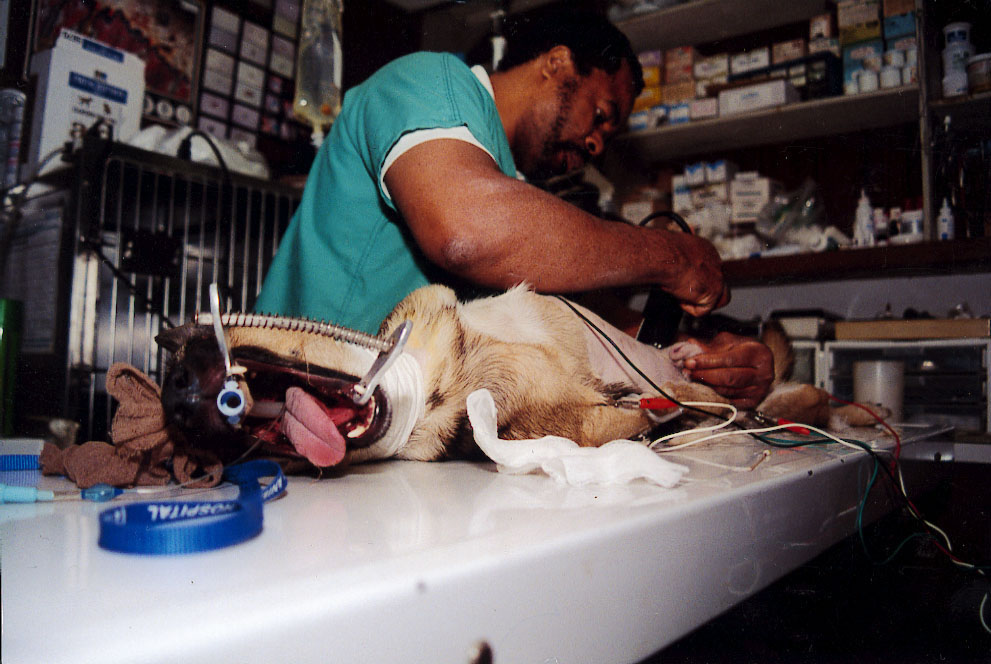
Surgery Prep © Louisa J Curtis 1996
I was given a cap to cover my hair and a mask for my face as I watched with genuine amazement and fascination as she proceeded to open up the dog’s belly and search for the obstruction. There was a moment of concern as to whether or not I could stomach (no pun intended!) watching this event, and it certainly was a first for me, but I’m happy to report that I felt neither disgust nor nausea, nor did I pass out in the corner. Instead, I felt a rather strange sense of excitement and privilege at being allowed to observe and record the operation at such close quarters. Mind you, close quarters was the only way one could have witnessed it as the room was indeed tiny.
Having established that I was okay, the three of them, Dr. Butler and her two assistants Elon and Alem, then proceeded to make bets as to what the obstruction might actually turn out to be. “Chicken bones,” said one. “Corn cob” said another. For a moment I was almost shocked at their somewhat lighthearted approach to the situation at hand, but I soon realized that their joking was merely an example of team spirit and their sense of humor certainly took nothing away from their expertise.

Surgery © Louisa J Curtis 1996
Dr. Butler found the “corn cob” quite easily, an obvious-looking bulge in the middle of the intestines, which at this point were beginning to look a lot like a string of sausages hanging out over the edge of the dog’s gaping belly. She cut open the section of intestine and triumphantly removed the offending obstacle. She then cut out the now-infected section of intestine and started the laborious task of sewing the two ends back together again. “The biggest concern with this type of procedure,” she said, “is seepage. You have to sew it back up again really thoroughly with a lot of stitches.”
Approximately two hours and over a hundred stitches later, she had finally finished for the day. The dog’s belly was sewn back up together and a week later he was doing just fine. That same piece of corn cob had cost the dog’s owner several hundred dollars. “Expensive piece of corn,” she said to him as she reiterated for the thousandth time, “No table food!”

No More Chicken Wings! © Louisa J Curtis 1996
Many pet owners simply do not realize the potential damage they can cause their animals by giving them table food or allowing them to dig through the garbage cans. Somehow, Dr. Butler always managed to squeeze a confession out of her clients, even though they may have hotly denied the fact when the subject had initially been brought up! During the several weeks that I spent with Dr. Butler, I witnessed quite a few clients owning up to providing little treats as simple as a saucer of milk for a cat (a definite non-no, by the way) or as potentially hazardous as chicken wings given to a young puppy by its young owner.
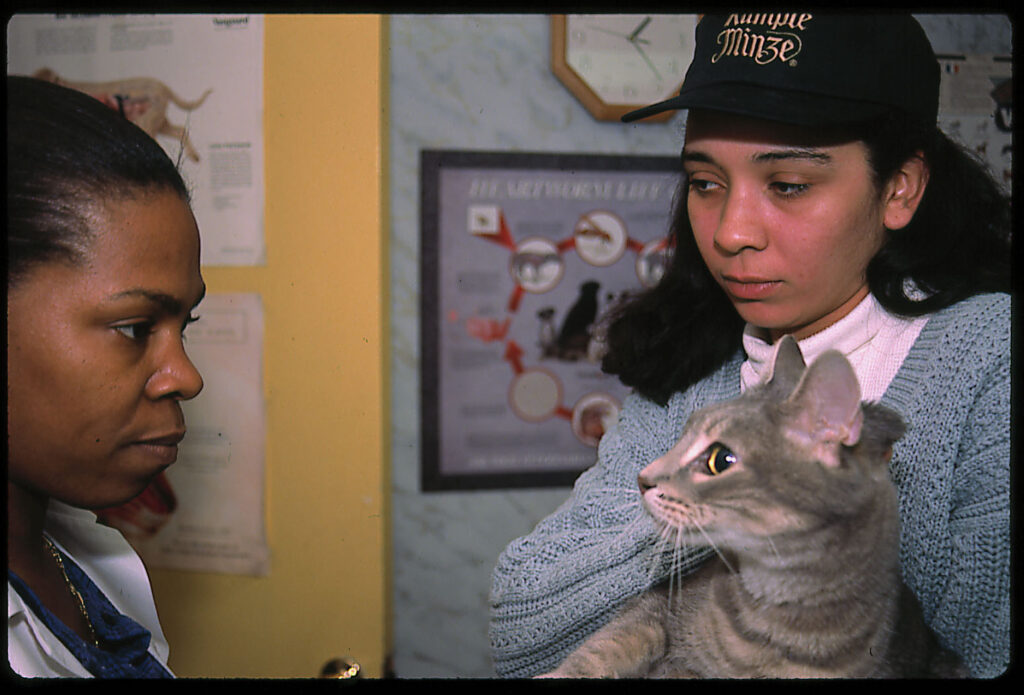
Stare Down © Louisa J Curtis 1996
She frequently prescribed special diets for animals depending on their age, weight and state of health. “If an animal is still eating but losing weight at the same time then you know something is wrong,” she said. Any change in an animal’s behavior, appetite, bowel movements and so on are all possible indications that something is not right, so these questions were frequently asked by Dr. Butler in order to find the necessary clues to solve the mystery of a pet’s illness. The animals themselves cannot tell us exactly what is going on, but they do send signals. It’s up to the owners to spot these signals and for the veterinarian to interpret them.
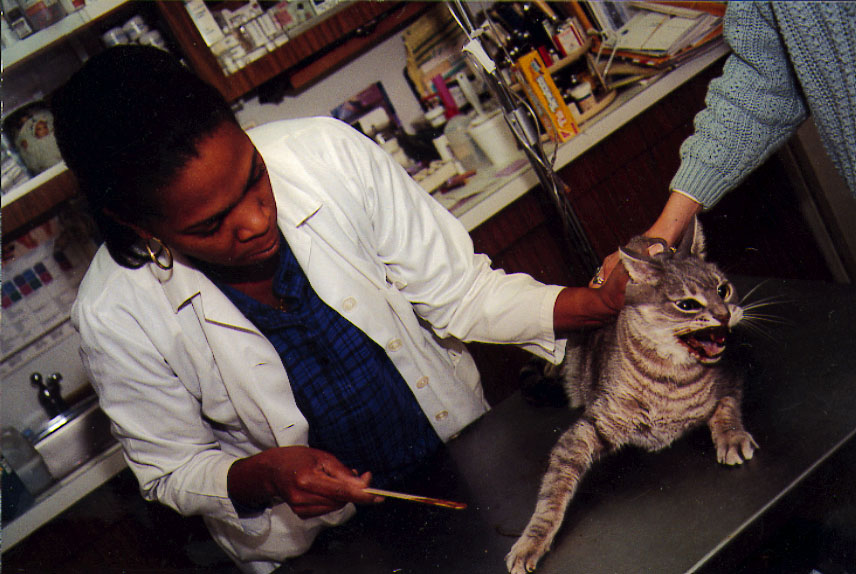
Don’t Touch Me! © Louisa J Curtis 1996

Up Your Bum! © Louisa J Curtis 1996
Another problem with animals not being able to “talk” to us is that certain symptoms could potentially relate to a number of different illnesses, so it becomes necessary to look at all of the possibilities and then eliminate them one by one until the piece of the puzzle fits the problem. Aside from her obvious medical knowledge, Dr. Butler used what I can only describe as her “woman’s intuition” and seemed very often to be right on the money when it came to figuring out exactly what was wrong with a particular animal.
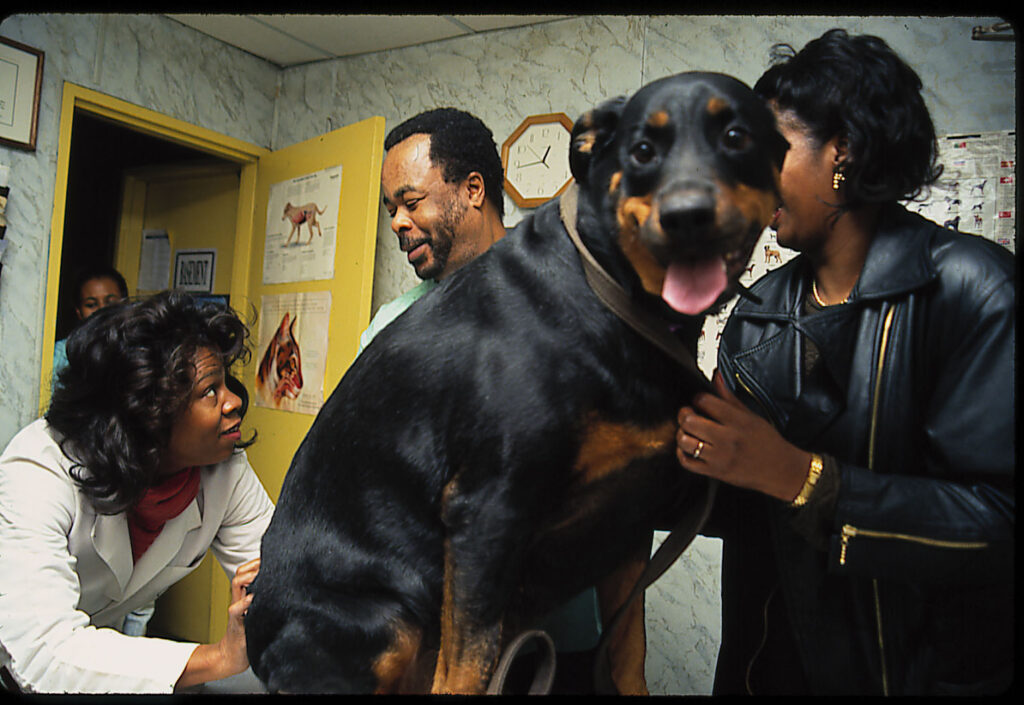
Can You Believe This? © Louisa J Curtis 1996
Often, she would talk the problem out loud and discuss it with her assistant at the time, Elon, who would add his own earthy contribution as they mulled over the symptoms and details together. All of this serious contemplation, however, was mixed in with a healthy dose of Jamaican humor which helped to create an atmosphere of humanity and levity, even in the most serious of circumstances.

Angora Rabbit © Louisa J Curtis 1996 Twains TwinesYes, this is a real rabbit, even though it reminded me of a certain soft toy I had as a kid which had a zipper in its stomach and a compartment in which to store your pajamas – this lady had a few long-haired pets and she used their fur in her fabric & “twine” designs – however, this bouncy looking bunny did not look so perky once Dr. Butler had cleaned the “mites” out of its ears….
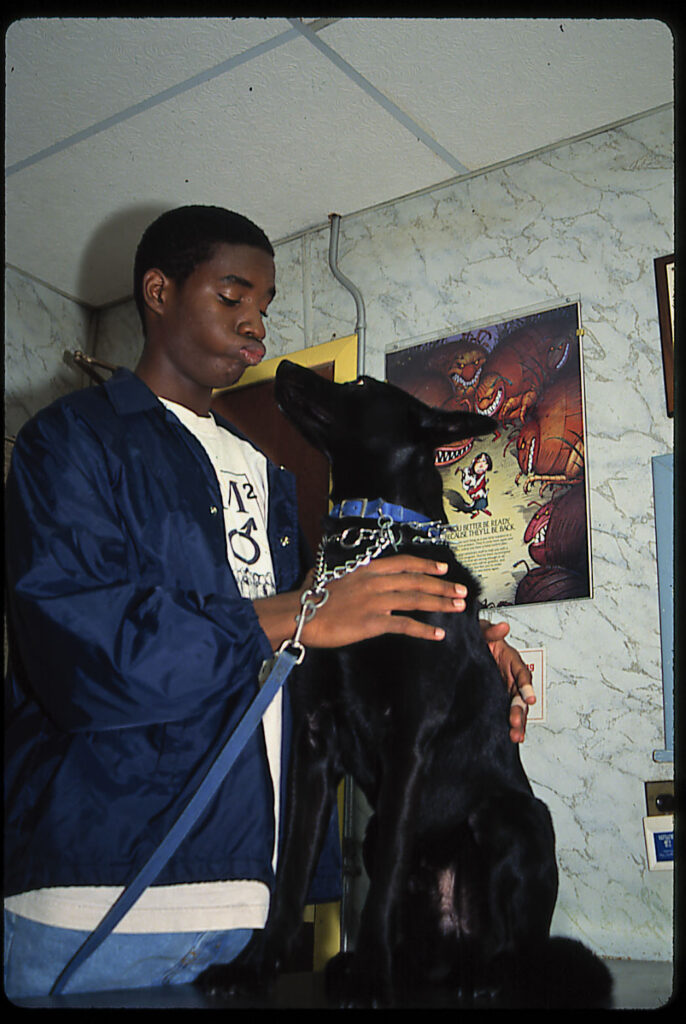
Go On Then Goofy, Give Us A Kiss! © Louisa J Curtis 1996
Dr. Butler would say it like it is. She didn’t beat around the bush and was quite firm with her clients in order to get her messages across to them. People would often come to her completely clueless as to how to take care of a pet properly, and I’m not just talking about the kids either, the adults were just as bad. Many of them just did not realize what a huge responsibility it is to take care of an animal, nor did they realize that it can also be a very costly business. The patients may only be “animals” to some people, but they have the same illnesses as we humans which therefore require the same kinds of “costly” treatments. We all know that health services do not exactly come cheap in this country, so why would we expect it to be otherwise for our pets?
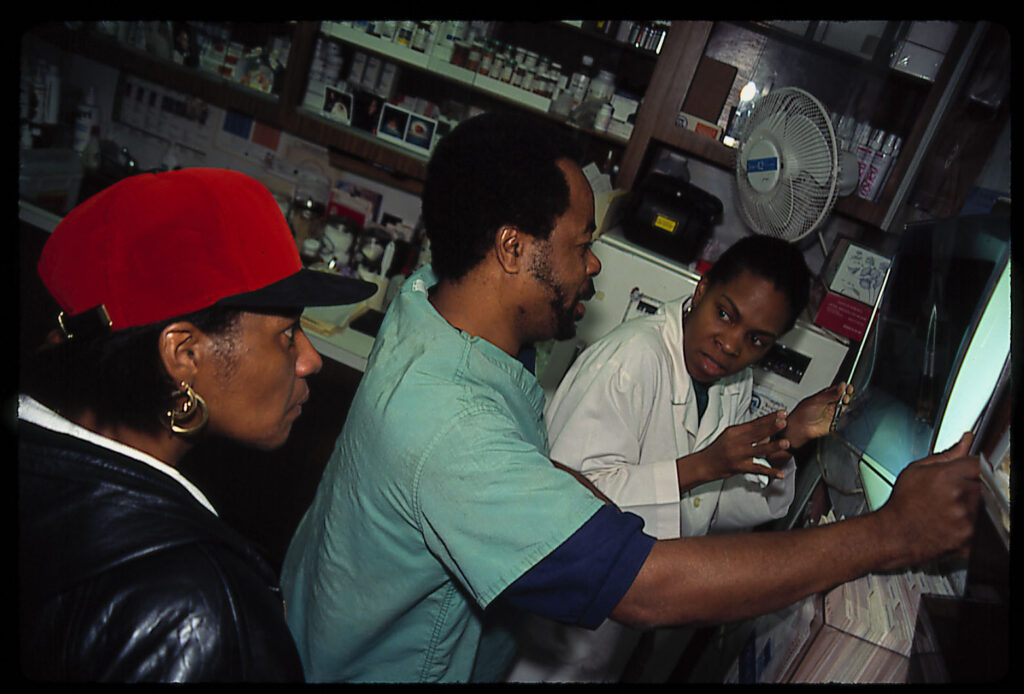
X-ray © Louisa J Curtis 1996 This woman had just found out that her dog was pregnant, but what had her completely horrified was when she realized that the only dog that had access to her bitch in heat was the dog’s brother and she now had a case of canine incest on her hands!
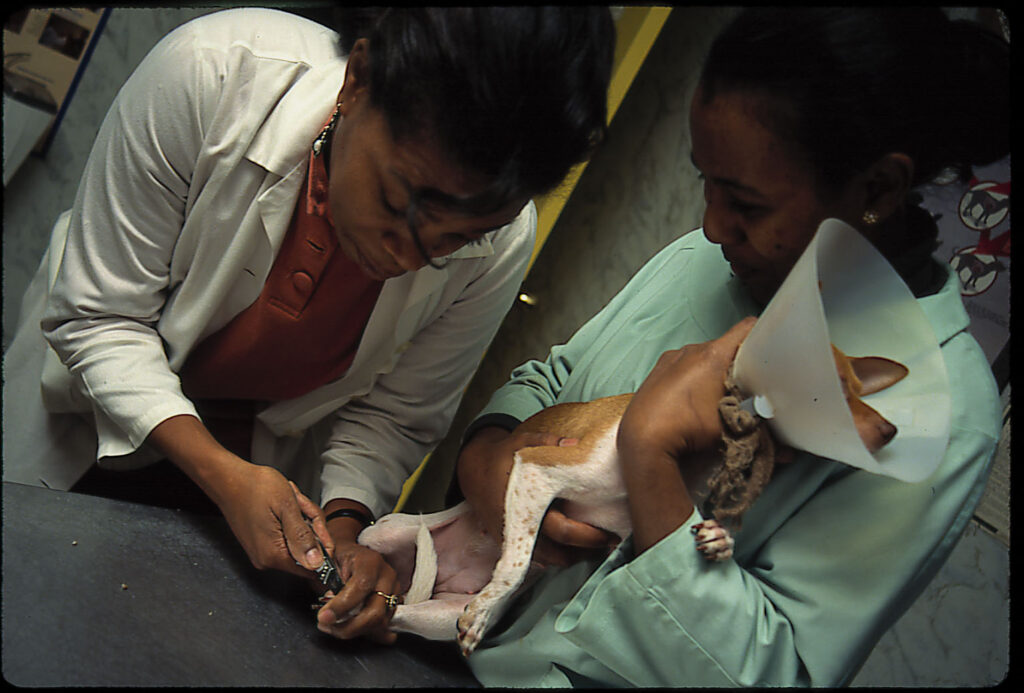
Pedicure © Louisa J Curtis 1996
Being a good veterinarian is not simply about taking care of the animals, it is also very much about how to handle the owners, so good people skills are a must. I got the impression that Dr. Butler could probably work with the animals practically blindfolded with her hands tied behind her back. In other words, dealing with the animals was the easy part, but handling the humans required a different type of energy and skill. Some of her clients may not always do as she asked but I got the distinct impression that she was well-liked and respected by them. Many people would come to her through other’s recommendations, and some would travel considerable distances to have her attend to their beloved pets, myself included.

Dog & Cone © Louisa J Curtis 1996
On another Saturday afternoon in November 1996, we witnessed a cat lose at least two of its nine lives. It had been a relatively quiet day for her up until that point and she was just in the middle of telling me how much she was looking forward to finishing early for a change and spending a few precious hours alone with her husband Claude as the kids were elsewhere that day, when Melody, the receptionist came rushing into the room concerned about the way this old lady’s cat was laying in his box in the waiting room. Her instincts had rightly told her that something was indeed seriously wrong with the cat, as we were all about to find out…
“Selica” was brought back into the examination room straight away and at first glance appeared to be dying right in front of us. The old lady and her grand-daughter seemed completely dazed as they watched everyone rush the poor animal back into the tiny operating room where it was immediately put on oxygen.
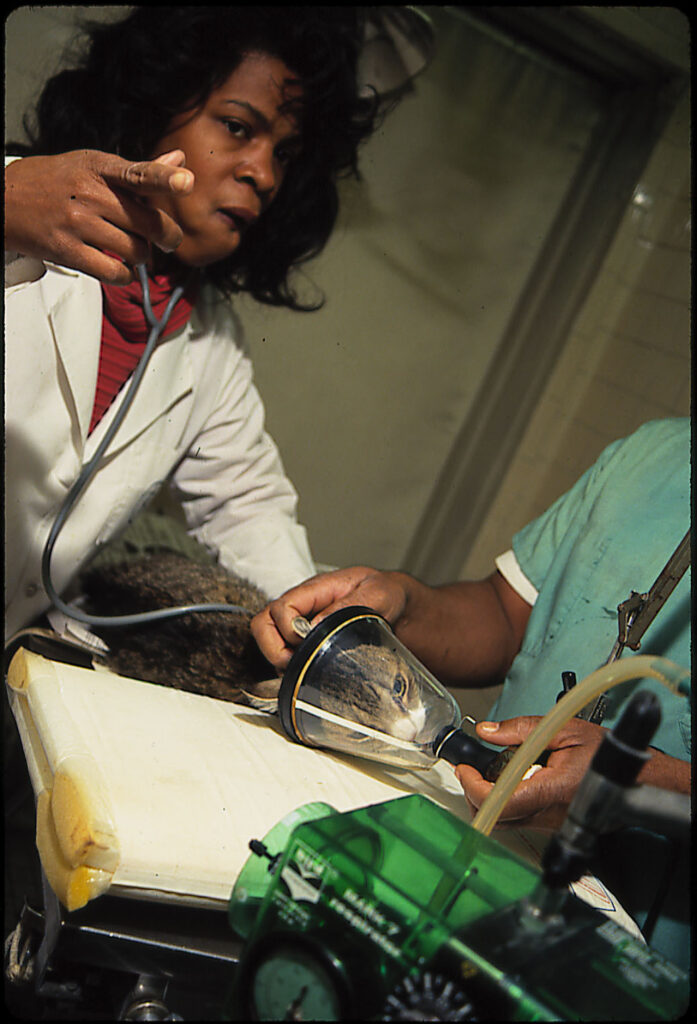
Oxygen Mask © Louisa J Curtis 1996
A snap decision had to be made then and there. “Do you want me to save this cat?” Dr. Butler asked the old lady with some urgency in her voice as time was apparently running out. The cat’s owner wasn’t ready to suddenly lose her precious pet, and even though the potential financial costs were briefly explained to her, she still went ahead and signed the necessary release paperwork allowing Dr. Butler to proceed. The circumstances were indeed difficult as the animal was literally at death’s door.
In retrospect, he should probably have been allowed to go at that point, but when a pet has become such a constant and faithful companion to a human being, it is not always possible to clearly see what the best plan of action might be; especially when one is at the height of an emergency and experiencing such an emotionally filled situation. This poor cat had to have been sick for quite some time and either his owner simply had not noticed, or she was in denial about the whole thing. Apparently, Selica used to weigh about eighteen pounds or so, which is a pretty substantial size for a cat, but now he was reduced to almost half of that weight, and had been diagnosed to be chronically diabetic, thus needing insulin injections every couple of hours until he stabilized. “There goes my weekend,” said Dr. Butler…

Selica © Louisa J Curtis 1996
With that first emergency now over, Selica was now lying in the recovery area attached to all sorts of tubes and wires, whilst his owner was allowed to come in and talk to him for a few moments. She, poor woman, then had to go back home to get more money as her bill had already far exceeded her expectations for that afternoon. In the meantime, as Elon was attempting to put another IV into the cat’s artery, the cat went into seizure again and was once more rushed back into the operating room. This poor animal was so sick and so stressed that just a simple procedure or even a touch was likely to send him over the edge.
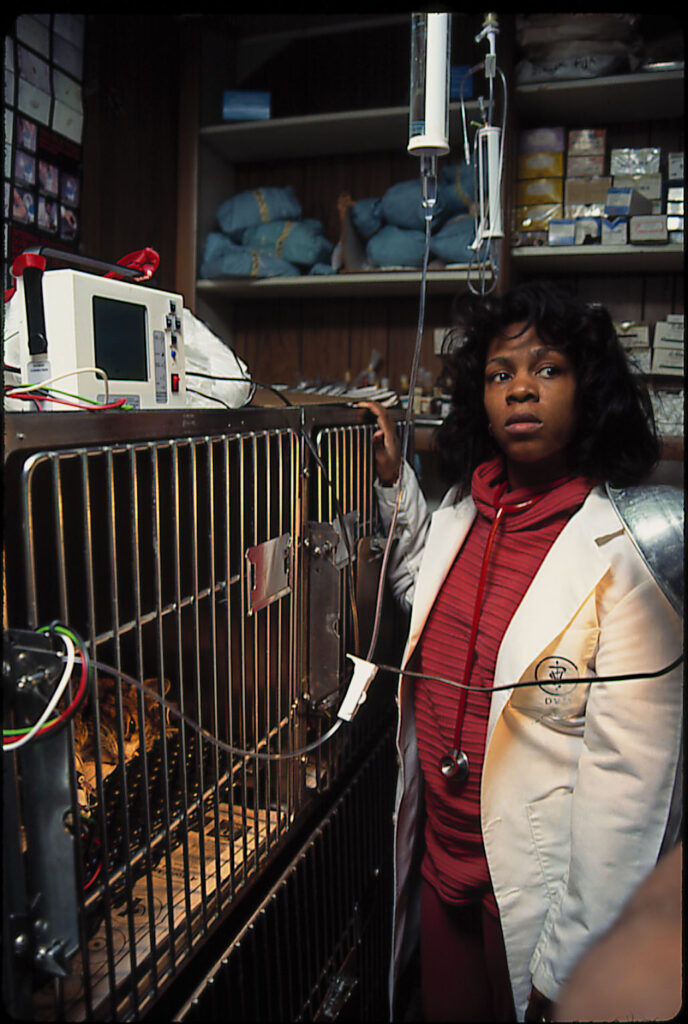
Cage © Louisa J Curtis 1996
Sometime later, he had once again been stabilized and was finally put into a cage for the night. Dr. Butler would be monitoring him throughout the night and then Elon would come back in on Sunday to take over. I would like to be able to tell you that Selica made it, but sadly he died the following day, and that little old lady was left with a huge bill to pay and no pet. As a matter of course, any client that loses an animal is sent a sympathy card from the 145th Street Animal Hospital, and payment plans for large bills are worked out wherever possible.
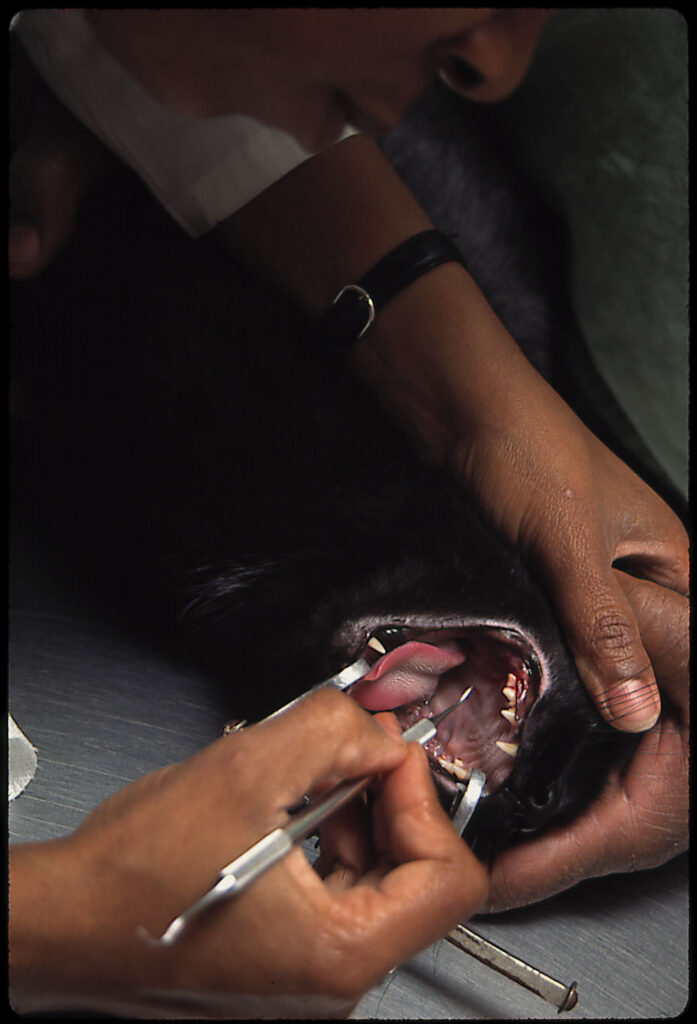
Dentistry © Louisa J Curtis 1996
As well as being a hard-working veterinarian, Dr. Butler also successfully wore a few other hats. She was a loving wife and mother of two children, very much involved in their school’s workings as well as being President of the Trustee Board of her local Lutheran Church. Her busy life revolved around her work, her family and her faith.
From the age of about seven or eight Julie Butler decided that when she grew up she wanted to become a veterinarian, and against all odds she stuck to her dream and she succeeded. The eldest of five children, she was born in Washington, D.C. but her parents moved to the New York City area when she was just six months old. Her father was an electrician, her mother a schoolteacher. Her father had always wanted to be a doctor, but with all of the mouths he had to feed, putting himself through medical school was cost-prohibitive and simply out of the question. Instead, his dream was passed on to his offspring with his eldest daughter becoming a veterinarian and another daughter becoming a doctor.
Educated at Wellesley College and Cornell Vet School, Dr. Butler also spent a year in Nairobi, Africa studying animal behavior through the Waddell scholarship program out of Emory University in Atlanta. She was particularly interested in reptiles and still had a glass tank in her office upstairs full of snakes!

Family © Louisa J Curtis 1996
Animals aside, she also possessed a great love for the arts and enjoyed music, theater and dance. At the time I photographed her for this story she was taking violin lessons along with both of her children, Alex and Zora at the Harlem School of Arts, all with the same teacher. She had an unwritten agreement with her husband Claude (who worked as a Contract Negotiator for Doctors) that in order for her to be able to pursue her career and succeed in running her own veterinary business he took on a large role in the caretaking of their two children.

Paperwork © Louisa J Curtis 1996
Dr. Butler took over The 145th Street Animal Hospital from her predecessor, Dr. Tait on April Fool’s Day when she was four and a half months pregnant with Zora. She had previously trained with Dr. Tait at another animal hospital where she told me he had her relentlessly performing surgery after surgery. All that practice certainly paid off when he unexpectedly took a sabbatical and she stepped in for him at the animal hospital on 145th Street. He subsequently retired and she took over the practice and the business while continuing to build a well-earned reputation of her own.
At that point, instead of driving in from Brooklyn to Harlem every day, the family moved into the brownstone building in which the animal hospital was situated and her daily commute became a flight of stairs. Even though the commute was now much shorter, the hours she put into the job, however, grew longer and longer. After several years of living upstairs above the animal hospital, the family was finally able to purchase their own home, conveniently located just a few blocks away on Convent Avenue. They then spent several years restoring and renovating the wonderful old brownstone to its former beauty.

Bath Time © Louisa J Curtis 1996
When I originally wrote this story, Dr. Butler was still in the process of purchasing the business from Dr. Tait so funds were tight, which prevented her from being able to hire any more staff or upgrade the facilities, which of course, she would love to have done, but that would have to wait. At the time her small staff included her assistant Elon (a Jamaican like Dr. Tait), a young trainee from Ethopia called Alem, a receptionist Melody, and a part-time groomer Anneliese (who had a thick German accent!).
It was a small outfit and even though the place had a decidedly “older” feel to it, one never got the impression that the animals were any less cared for just because they weren’t housed in a nice shiny white facility with gleaming new equipment! The 145th Street Animal Hospital possesses a lot of character and displayed a strong sense of caring. Dr. Butler was always on the lookout for new knowledge and was willing to investigate alternative and even homeopathic treatments. She regularly prescribed vitamins for dogs and cats with allergies, skin and coat problems. She would also attend out-of-town conferences and then bring back new and updated information which she would then be able to apply in her own veterinary practice. With her, the learning never stopped.
Louisa J. Curtis

